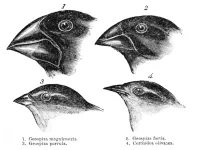(Press-News.org) ROCHESTER, Minn. — Melanoma, an aggressive form of skin cancer that accounts for 75% of all skin-cancer-related deaths, is often detected later in people with darker skin complexions — and the consequences can be devastating, a Mayo Clinic study reveals.
While melanoma may be found less frequently in people with darker complexions than fair ones, this potentially serious form of cancer can strike anyone. The study, which consisted of 492,597 patients with melanoma, suggests that added vigilance in early screening is particularly needed for Black men, whose cancers are often found at later stages, leading to worse outcomes compared to white patients.
"We compared non-Hispanic Black patients to white patients and saw striking differences in how patients presented with the disease," says surgical oncologist Tina Hieken, M.D., senior author of the study and a researcher at Mayo Clinic Comprehensive Cancer Center. "We saw more extremity melanoma, and more later-stage disease."
Extremity melanoma refers to skin cancer that can develop on the arms, legs, hands and feet. Various factors, including social risk factors and biological components, could be at play, but further research is needed to help determine why these differences exist.
Revealing differences in sex-based immune response
The research found that Black female patients with melanoma fared better than Black male patients.
Men tended to be older at diagnosis and more likely to have cancer that had spread to their lymph nodes compared to women. This translated to worse survival rates. The researchers learned that Black men with stage 3 melanoma have only a 42% chance of surviving for five years, compared to 71% for Black women.
Most research on melanoma hasn't focused on how race and sex affect outcomes and hasn't looked at the influence of race and ethnicity across all groups. Dr. Hieken says the study highlights the need to understand these differences better, noting that this is the first large study to confirm that sex‐based differences in melanoma outcomes exist within the non-Hispanic Black population.
"When we talk about later-stage melanoma patients who are female versus male in that non-Hispanic Black patient cohort who ended up doing worse, some biological things may be going on here that are interesting," says Dr. Hieken.
One theory centers on variations in immune response.
"Several immune signals suggest that women may respond better to some immunotherapies than males," says Dr. Hieken.
Identifying the need
Researchers note that more studies focused on melanoma in a broader range of people, including more Black participants in clinical trials, is key to bridging this knowledge gap and potentially identifying more effective treatments.
"We want to broaden and deepen our reach to better understand the disease that affects all patients," says Dr. Hieken.
She underscores the role played by the Mayo Clinic Robert D. and Patricia E. Kern Center for the Science of Health Care Delivery in this study.
"What we've done with the Kern Center, with this study and others, is to identify the need," says Dr. Hieken. "We have a rich, integrated, multidisciplinary clinical research practice in melanoma, and we want to address clinical needs and knowledge gaps relevant to our practice."
A wake-up call in the battle against melanoma
Dr. Hieken notes that this study is a wake-up call for everyone battling to diagnose and cure melanoma, regardless of the patient's sex or skin tone.
She emphasizes that healthcare professionals should carefully examine areas like palms, soles and under fingernails, where melanoma might be more challenging to spot on darker skin.
"We can incorporate screening for skin lesions or lesions under the nails into the visit for patients as part of their regular checkups," says Dr. Hieken. "What we want to do is elevate care for our patients."
The Mayo Clinic Robert D. and Patricia E. Kern Center for the Science of Health Care Delivery and Breast and Melanoma Surgical Oncology in the Department of Surgery supported this research. Review the study for a complete list of authors, disclosures and funding.
###
About Mayo Clinic Robert D. and Patricia E. Kern Center for the Science of Health Care Delivery
The Mayo Clinic Robert D. and Patricia E. Kern Center for the Science of Health Care Delivery collaborates with clinical areas across Mayo to create and evaluate data-driven solutions to transform the experience of health and healthcare for patients, staff, and communities. It drives continuous improvement of Mayo Clinic as a learning health system, enabling always safe, evidence-based, high-quality care.
About Mayo Clinic Comprehensive Cancer Center
Designated as a comprehensive cancer center by the National Cancer Institute, Mayo Clinic Comprehensive Cancer Center is defining new boundaries in possibility, focusing on patient-centered care, developing novel treatments, training future generations of cancer experts and bringing cancer research to communities. At Mayo Clinic Comprehensive Cancer Center, a culture of innovation and collaboration is driving research breakthroughs that are changing approaches to cancer prevention, screening and treatment, and improving the lives of cancer survivors.
END
Melanoma in darker skin tones: Race and sex play a role, Mayo study finds
2024-05-10
ELSE PRESS RELEASES FROM THIS DATE:
Visual experiences unique to early infancy provide building blocks of human vision, IU study finds
2024-05-10
What do infants see? What do they look at? The answers to these questions are very different for the youngest babies than they are for older infants, children and adults. Characterized by a few high-contrast edges in simple patterns, these early scenes also contain the very materials needed to build a strong foundation for human vision.
That is the finding of a new study, “An edge-simplicity bias in the visual input to young infants,” published on May 10 in Science Advances by IU researchers Erin Anderson, Rowan Candy, Jason Gold and Linda Smith.
“The starting ...
Clues from deep magma reservoirs could improve volcanic eruption forecasts
2024-05-10
New research into molten rock 20km below the Earth’s surface could help save lives by improving the prediction of volcanic activity.
Volcanic eruptions pose significant hazards, with devastating impacts on both people living nearby and the environment.
They are currently predicted based on activity of the volcano itself and the upper few kilometres of crust beneath it, which contains molten rock potentially ready to erupt.
However, new research highlights the importance of searching for ...
Scientists unlock key to breeding ‘carbon gobbling’ plants with a major appetite
2024-05-10
The discovery of how a critical enzyme “hidden in nature’s blueprint” works sheds new light on how cells control key processes in carbon fixation, a process fundamental for life on Earth.
The discovery, made by scientists from The Australian National University (ANU) and the University of Newcastle (UoN), could help engineer climate resilient crops capable of sucking carbon dioxide from the atmosphere more efficiently, helping to produce more food in the process.
The research, published in Science Advances, demonstrates a previously unknown function of an enzyme called carboxysomal carbonic anhydrase (CsoSCA), which is found in cyanobacteria – also called ...
Hubble celebrates the 15th anniversary of servicing Mission 4
2024-05-10
Fifteen years ago, human hands touched NASA's Hubble Space Telescope for the last time.
As astronauts performed finishing tasks on the telescope during its final servicing mission in May 2009, they knew they had successfully concluded one of the most challenging and ambitious series of spacewalks ever conducted. But they couldn’t have known at the time what an impact they had truly made.
“I had high hopes that Hubble would last at least five years more, and maybe even a little more to overlap with Webb,” said astronaut and former associate administrator for NASA's Science Mission Directorate John ...
Hints of a possible atmosphere around a rocky exoplanet
2024-05-10
55 Cancri e is one of five known planets orbiting a Sun-like star in the constellation Cancer. With a diameter nearly twice that of Earth and a density slightly greater, the planet is classified as a super-Earth: larger than Earth, smaller than Neptune, and similar in composition to the rocky planets in our solar system.
Brice-Olivier Demory from the Center for Space and Habitability CSH of the University of Bern and member of the NCCR PlanetS is co-author of the study that has just been published in Nature. He ...
UVA Data Art Competition draws more than 130 submissions and announces winners
2024-05-10
Data has the power to tell captivating stories and reveal hidden insights, often in aesthetically compelling ways.
In celebration of this, the University of Virginia’s School of Data Science hosted an art competition to commemorate the opening of its new building and to invite participants from all over the world to tell unique stories by transforming raw data into art. The School received more than 130 submissions from nine countries, far exceeding expectations for an inaugural competition.
After selecting eight finalists from a wide range of artistic formats, the winners were announced during ...
Why so many jobs are boring: New MSU study identifies large interest gaps in US labor market
2024-05-10
MSU has a satellite uplink/LTN TV studio and Comrex line for radio interviews upon request.
EAST LANSING, Mich. – A recent study out of Michigan State University found large gaps between people’s career interests and U.S. job demands. These gaps indicate that the interest demands of the U.S. labor market differ drastically from the supply of interested people, revealing how many people have unfulfilled interests at work.
The study, published in the Journal of Business and Psychology, is the first to look at labor gaps using career ...
Navy Growler jet noise over Whidbey Island could impact 74,000 people’s health
2024-05-10
Bob Wilbur thought he’d found a retirement home that would be a place of peace. Nestled against Admiralty Bay on the western edge of Whidbey Island, the three-story house is surrounded by trees and shoreline. It offers the kind of quiet that only an island can provide. Except when the Growlers fly.
As often as four days a week, Boeing EA-18G Growler electronic attack aircraft based at the nearby Naval Air Station Whidbey Island fly loops overhead as pilots practice touch-and-go landings. The noise is immense, ...
Research shows impact of caregiving on parents’ employment, health
2024-05-10
When it comes to improving the lives of children with genetic conditions, medical research often focuses solely on the children. But there is an equally important population in need of research that a faculty member at the University of Colorado Department of Medicine is highlighting — the caregivers.
“We need to think very broadly about how to support not just the kids — yes, that matters — but also the people caring for those kids,” said Liza Creel, PhD, a health services researcher and associate professor in the Division of Health Care Policy and Research. “I want to do work that ...
Unlocking the secrets of evolution
2024-05-10
Ever since Darwin published his landmark theory of how species evolve, biologists have been fascinated with the intricate mechanisms that make evolution possible.
Can mechanisms responsible for the evolution of a species over a few generations, called microevolution, also explain how species evolve over periods of time extending to thousands or millions of generations, also called macroevolution?
A new paper, just published in Science, shows that the ability of populations to evolve and adapt over a few generations, ...


